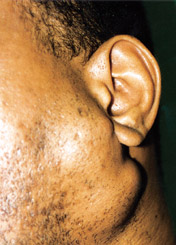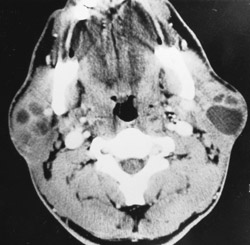
Am Fam Physician. 2000;62(7):1619-1620
A 35-year-old man sought medical advice for evaluation of asymptomatic bilateral masses of the face (Figure 1). The masses had developed four months previously and had gradually increased in size.
The patient's medical and surgical history was unremarkable. He had a history of sexual activity with several women, without use of condoms.
Physical examination showed slightly hard bilateral facial masses with no signs of inflammation. The examination of the mouth (including the teeth) was normal. No organomegaly, enlargement of the lymph nodes or other abnormal finding was apparent in the rest of the examination. Routine laboratory evaluation included a complete blood cell count, measurements of blood urea, creatinine, glucose and electrolyte levels, liver function tests and a urinalysis. All findings were normal. A chest radiograph was normal. A computed tomographic (CT) scan of the area with the masses is shown in Figure 2.


Question
Discussion
The correct answer is D: benign lymphoepithelial cystic lesions of the parotid glands in a patient with human immunodeficiency virus (HIV).
Mumps is rarely seen now because of effective immunization. Bilateral parotid enlargement is a common presentation, but infected individuals would have symptoms of systemic illness (e.g., fever, myalgias, malaise) and a more acute time course for the parotid enlargement.
Warthin's tumor is more common in men and can cause cystic enlargement of the parotid but is bilateral in only about 5 percent of cases. Diagnosis is made by its typical histologic appearance on biopsy.
Suppurative parotitis can present with bilateral parotid enlargement but is an acute and inflammatory process. It is usually due to infection with Staphylococcus aureus and is typically seen in elderly, debilitated patients (e.g., after chemotherapy or during postoperative recovery from major surgery or trauma).
Bilateral slow-growing enlargement of the parotids is a classic, but not common, finding in sarcoidosis. Cystic involvement of the gland is not typical, and the large majority of patients will have respiratory complaints and abnormalities on radiography of the chest.
Benign lymphoepithelial cystic lesions of the parotid glands occur in a small proportion of patients who have HIV, especially during the early stages of the infection. Cystic lesions of the parotid glands should indicate the need for HIV testing. A CT scan of the mass is helpful for the differential diagnosis in HIV patients, which includes tuberculosis, atypical mycobacterial infection, Kaposi's sarcoma, lymphoma and several types of parotid gland neoplasms. Fine-needle aspiration may be necessary in patients whose diagnosis is uncertain.
The pathogenesis of benign lymphoepithelial cystic lesions of the parotid glands is not clear. It was thought for several years that these lesions developed from already-existing lymphoid tissue in the salivary glands. However, newer studies suggest that the cause of the lesions is a secondary lymphoid tissue infiltration of the salivary glands associated with HIV infection.1
Several therapeutic approaches have been tried, including surgical excision, low-dose radiation and intralesional infusion of a sclerosing agent (doxycycline [Vibramycin]).2 However, good results are achieved using active combination antiretroviral therapy, which leads to a substantial decrease or even disappearance of the cystic lesions of the parotid glands in most patients.3,4 Treatment is mainly indicated for cosmetic reasons or relief of any discomfort.